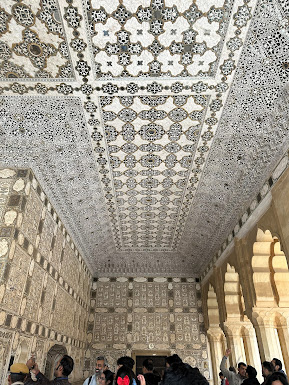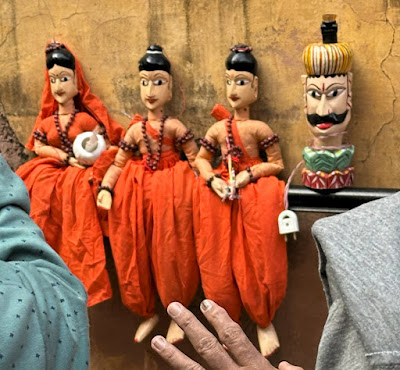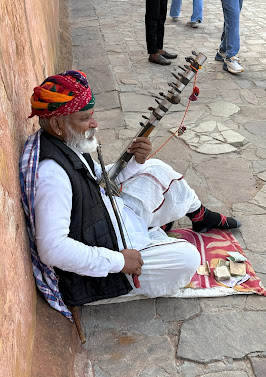December 29, 2024
It is about 150 miles from Agra to Jaipur via Fatehpur Sikri, and altogether the drive took us almost five hours. Again, we were so glad we had a large van with AC and a very experienced driver. By the time we arrived at our hotel, we were worn out and the day was pretty much over.
Bob had booked rooms in a five-star hotel, the Samode Haveli, which was initially built in the 16th century as a fort but was converted into a palace in the early 19th century by Samode Haveli, the Prime Minister of Jaipur. In 1987 it was converted again, but this time into what is called a "Heritage Hotel," which is a building that has historical or architectural significance and has been made into a hotel. Heritage hotels are usually tied in some way to royalty, nobility, or prominent families.
It is gorgeous inside, but the hallways are a maze and we got lost a couple of times on our first day there. It was a little like wandering the back alleys of Delhi, but on a very grand scale!
Kite-flying is a huge sport in India, and we saw several downed kites in the trees on the hotel property. We loved the mosaics that we saw everywhere in India, even on the hotel floors!
The check-in desk is not the traditional counter with a computer.
Stan, I think Chris has some remodeling plans in mind.
Our room was not as nice as some of our other rooms on this trip, but we had a really large suite comprising multiple rooms.
The hotel had a nice gift shop where Bob bought this watercolor of a hummingbird painted on a piece of old paper with writing on the back, probably passages from the Quran. I bought a purplish-colored star sapphire ring that has become one of my favorite pieces of jewelry.
After breakfast we had a guide pick us up for a half-day tour of the Amber Fort, aka Amer Palace or Amer Fort. (Until I came home and looked it up, I thought it was called Amber Fort because so many of the buildings were yellow or gold in color. Nope. It is named after the region, which is Amer.) Most of the fort is taken up by a palace built by Raja Man Singh I, who ruled the area from 1590 to 1614 AD. The palace and fort were declared a UNESCO World Heritage Site in 2013.
Because the palace is on top of a hill and is accessed by a single very narrow, steep, twisty-turny road, only approved vehicles can take tourists up. We drove to a large parking lot next to Maotha Lake and waited for our turn to get a taxi. And waited. And waited. And then waited some more. While we waited, we looked for crocodiles, but we didn't see any. Darn.
There had also been an option to ride an elephant to the top, but our tour company, Audley Travel, objects to that mode as being cruel to the elephants, whose feet are not made for the steep cobblestone streets.
When we FINALLY made it to the top, it was very crowded. It is the main tourist attraction in Jaipur, so no surprise. We entered through the beautiful
Ganesh Pol (
pol = gate), which is covered with elaborate frescoes . . .
. . . and an image of the elephant god Ganesh . . .
. . . and a complex geometric design inside the upper dome:
The Ganesh Pol leads to the private palaces of the king. The paintings on the ceilings and walls include gold leaf that shimmers when the light hits it.
I would call the Amber Fort, at least the palace part, the Versailles of India.
One of the most beautiful structures in the entire palace is the
Sheesh Mahal or Mirror Palace, which was started in the 16th century but not finished until 1727. Mosaics made of millions of tiny mirrors cover the walls and ceilings.
It's a very popular photo spot.
Prepare yourself for a flood of photos. These are just a selection of the hundred or so I took inside this palace of mirrors.
Remember that these window screens are carved rock, not wood and not woven.
From the balcony (above right) we had a panoramic view of Maotha Lake and a man-made island in the center, Kesar Kyari Bagh, which was created around 1600 for the pleasure of the women in the harem. The name translates to "saffron-growing garden," so-named for the crop that was originally planted there.
We could also see the elephant taxis in the courtyard below. Poor elephants.😢
This tourist caravan caught my eye--or at least their HATS did. Can't miss those.
There is something about this architecture that is just so MUGHAL to me.
Maybe it is that the roof line reminds me of the Mughal headgear, especially Humayan's (whose magnificent tomb we saw in Delhi) and Akbar's (whose palace we had seen at Fatehpur Sikri the day previous).
 |
| Illustration from here |
From one of the balconeys we had a great view of the Jaipur Wall (aka Amer Wall, aka "Great Wall of Amer"), a 7-mile-long defensive structure on the mountain ridges encircling the palace. It reminded us a lot of the Great Wall of China.
The royal family lived in the
Sukh Mandir ("Temple of Contentment") Palace, located just off the garden, which is sculpted in a classic Mughal pattern called
char-bagh (four gardens).
The palace was kept cool in the summer by covering the arched windows with woven grass mats that were moistened periodically with water. Air passing through the mats was cooled and also carried the scent of the grass into the chambers.
The
Baradari Pavilion has twelve doors (
Bara means "twelve" and
dari means doors") to maximize air circulation. This building was used by the royal queens for meetings and gatherings, for dance performances by noble courtesans, and for live concerts by poets and musicians. The pavilion is situation in the center of the
Man Singh I Palace Square.
There are plenty of viewing spots from these many windows and balconys . . .
. . . or from the towers on each corner:
When it was time to head back down the twisty-turny narrow road, we noticed that the rim of the fort was crawling with vendors, something the Amber Fort has been criticized for.
The one that caught our eye, however, was not selling an item, just his music and his smile. His instrument is called a
Ravanahatha, and it is one of the oldest musical instruments in India. You can see a recording I made of this man playing his instrument
here.Bob got a real kick out of him. I love this photo of the two of them!
Well, time to move on. Too bad we didn't get to take this rickshaw down the hill. I'm sure it would have been a thrilling ride!

On our way back to the city center of Jaipur, we stopped for just a minute at this photo spot, the Jal Mahal (which means "Water Palace"). It is a palace in the middle of the Man Sagar Lake. How does a palace end up apparently floating in a lake? It was originally constructed around 1699 as a hunting lodge for the king and his entourage during duck hunting trips. As you can imagine, it has undergone many restoration projects in the 326 years since then. There are four levels beneath the one that you see here that need to be constantly water-proofed and reinforced.
Today it is known as one of the best places for a photo in Jaipur--somewhat like Sleeping Beauty Castle in California's Disneyland.








































































(Bob) The Amber Fort and its "great wall" are spectacular. I think I liked the overall setting and architecture more than some of the artistic details which I enjoyed more at some other locations. I wish we'd ridden the elephants up to the Fort.
ReplyDelete